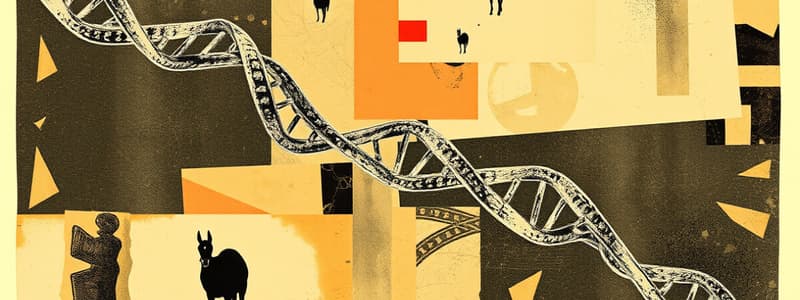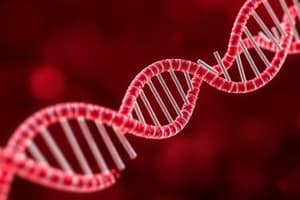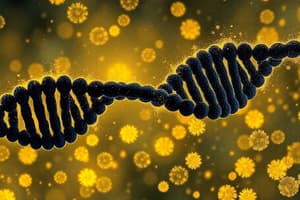Podcast
Questions and Answers
What is one outcome of exon splicing in protein synthesis?
What is one outcome of exon splicing in protein synthesis?
- It results in proteins being produced without any domains.
- It can give rise to different proteins due to alternative splicing. (correct)
- It has no effect on the diversity of proteins produced.
- It can lead to the formation of identical proteins.
During transcription, what is the role of RNA polymerase?
During transcription, what is the role of RNA polymerase?
- To remove introns from pre-mRNA.
- To synthesize RNA using the coding strand of DNA.
- To modify proteins after they are synthesized.
- To synthesize RNA using the non-coding strand of DNA. (correct)
The process that enables the production of different proteins from the same gene is known as:
The process that enables the production of different proteins from the same gene is known as:
- Intron retention.
- Gene duplication.
- Exon shuffling.
- Alternative mRNA splicing. (correct)
Which component is added during the RNA processing of pre-mRNA in eukaryotes?
Which component is added during the RNA processing of pre-mRNA in eukaryotes?
What is the primary function of mRNA in the process of gene expression?
What is the primary function of mRNA in the process of gene expression?
What is an effect of biotechnology on genetic material?
What is an effect of biotechnology on genetic material?
Which of the following correctly describes the relationship between DNA, mRNA, and proteins?
Which of the following correctly describes the relationship between DNA, mRNA, and proteins?
During transcription, which nucleotide base in RNA replaces thymine found in DNA?
During transcription, which nucleotide base in RNA replaces thymine found in DNA?
In eukaryotes, what is a key process that occurs after transcription?
In eukaryotes, what is a key process that occurs after transcription?
What term describes the entire genetic information of an organism?
What term describes the entire genetic information of an organism?
What structural difference makes RNA less stable than DNA?
What structural difference makes RNA less stable than DNA?
In the context of transcription, what does the term 'control region' refer to?
In the context of transcription, what does the term 'control region' refer to?
Which of the following statements is true regarding RNA synthesis?
Which of the following statements is true regarding RNA synthesis?
What do exons and introns represent in a gene's structure?
What do exons and introns represent in a gene's structure?
What is the Central Dogma of molecular biology primarily concerned with?
What is the Central Dogma of molecular biology primarily concerned with?
What is one of the primary roles of mRNA in the cell?
What is one of the primary roles of mRNA in the cell?
Which of the following best describes the template strand during transcription?
Which of the following best describes the template strand during transcription?
In transcription, which nucleotide replaces thymine found in DNA?
In transcription, which nucleotide replaces thymine found in DNA?
What is the primary enzyme involved in transcription?
What is the primary enzyme involved in transcription?
What is a promoter in the context of transcription?
What is a promoter in the context of transcription?
During which stage of transcription does RNA polymerase elongate the RNA strand?
During which stage of transcription does RNA polymerase elongate the RNA strand?
Where does transcription occur in eukaryotic cells?
Where does transcription occur in eukaryotic cells?
What happens at the terminator sequence during transcription in bacteria?
What happens at the terminator sequence during transcription in bacteria?
Which strand of DNA is referred to as the coding strand?
Which strand of DNA is referred to as the coding strand?
How is RNA synthesized during transcription?
How is RNA synthesized during transcription?
What is the primary role of transcription factors in eukaryotic transcription?
What is the primary role of transcription factors in eukaryotic transcription?
During elongation in transcription, RNA polymerase adds nucleotides at which end of the growing RNA strand?
During elongation in transcription, RNA polymerase adds nucleotides at which end of the growing RNA strand?
What is the function of the polyadenylation signal AAUAAA in eukaryotic transcription?
What is the function of the polyadenylation signal AAUAAA in eukaryotic transcription?
What modifications help protect mRNA from enzymatic degradation after transcription?
What modifications help protect mRNA from enzymatic degradation after transcription?
In eukaryotic cells, where does RNA processing primarily occur?
In eukaryotic cells, where does RNA processing primarily occur?
What is the main purpose of splicing in pre-mRNA processing?
What is the main purpose of splicing in pre-mRNA processing?
Which statement about RNA polymerase during elongation is correct?
Which statement about RNA polymerase during elongation is correct?
How do spliceosomes identify introns in the pre-mRNA?
How do spliceosomes identify introns in the pre-mRNA?
What role does the 5' CAP play in mRNA processing?
What role does the 5' CAP play in mRNA processing?
In the context of eukaryotic transcription, what follows the termination phase?
In the context of eukaryotic transcription, what follows the termination phase?
Flashcards are hidden until you start studying
Study Notes
DNA and RNA
- DNA (Deoxyribonucleic acid) encodes genetic information, while RNA (Ribonucleic acid) translates that information into proteins.
- RNA differs from DNA by having uracil instead of thymine and being generally single-stranded.
- Genomes encompass the complete genetic material of an organism.
Flow of Information
- Information flows from DNA to RNA to protein, termed the Central Dogma of molecular biology.
- Gene expression facilitates the transformation of DNA information into functional proteins or RNAs.
Transcription Overview
- Transcription is the process where RNA is synthesized from a DNA template.
- Similar to DNA replication, transcription requires complementary base pairing; however, thymine in DNA is replaced by uracil in RNA.
- RNA polymerase catalyzes RNA synthesis, operating in a 5' to 3' direction and does not require a primer.
Types of RNA
- mRNA (messenger RNA): Carries genetic information from DNA to ribosomes for protein synthesis.
- rRNA (ribosomal RNA): Forms structural components of ribosomes.
- tRNA (transfer RNA): Helps in the synthesis of amino acid chains.
Transcription in Prokaryotes vs. Eukaryotes
- Bacteria perform transcription without a nucleus and do not undergo RNA processing.
- Eukaryotic transcription takes place in the nucleus followed by RNA processing, while translation occurs in the cytoplasm.
Stages of Transcription
- The transcription process involves three stages: initiation, elongation, and termination, differing in details between prokaryotes and eukaryotes.
- Initiation: In eukaryotes, transcription factors assist RNA polymerase II binding to the promoter region (e.g., TATA Box).
- Elongation: RNA polymerase unwinds DNA and synthesizes RNA, adding about 40 nucleotides per second.
- Termination: In bacteria, a terminator signal leads to RNA polymerase detachment; in eukaryotes, a polyadenylation signal (AAUAAA) prompts release.
RNA Processing
- Eukaryotic pre-mRNA undergoes processing to form mature mRNA before translation.
- Modifications include the addition of a 5' cap and a poly A tail at the 3' end for stability and export from the nucleus.
Splicing and Alternative Splicing
- Introns are removed and exons (coding sequences) are spliced together by a complex known as the spliceosome.
- Alternative splicing allows different proteins to be produced from the same gene, enhancing protein diversity.
Importance of Transcription and RNA Processing
- RNA processing helps protect mRNA and facilitates its translation in the cytoplasm.
- Universal mechanisms of transcription and translation support the common ancestry of life and have applications in biotechnology, such as producing human insulin in bacteria.
Summary of Key Concepts
- RNA polymerase synthesizes RNA from a DNA template, with transcription initiated at promoters and terminated at specific sequences.
- Transcription results in pre-mRNA that undergoes processing to become functional mRNA, ready for translation into proteins.
Studying That Suits You
Use AI to generate personalized quizzes and flashcards to suit your learning preferences.




